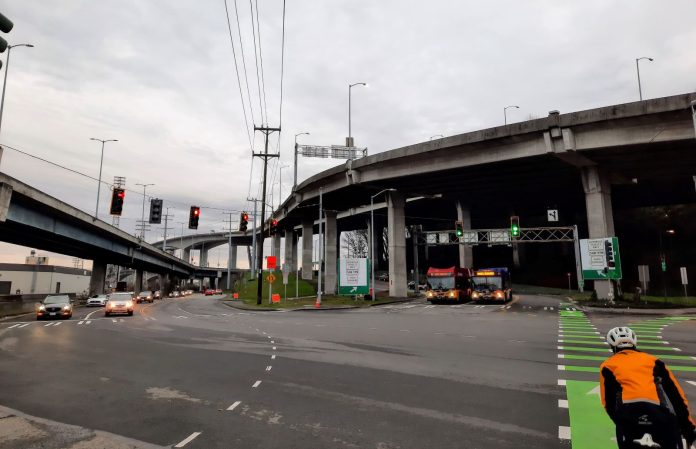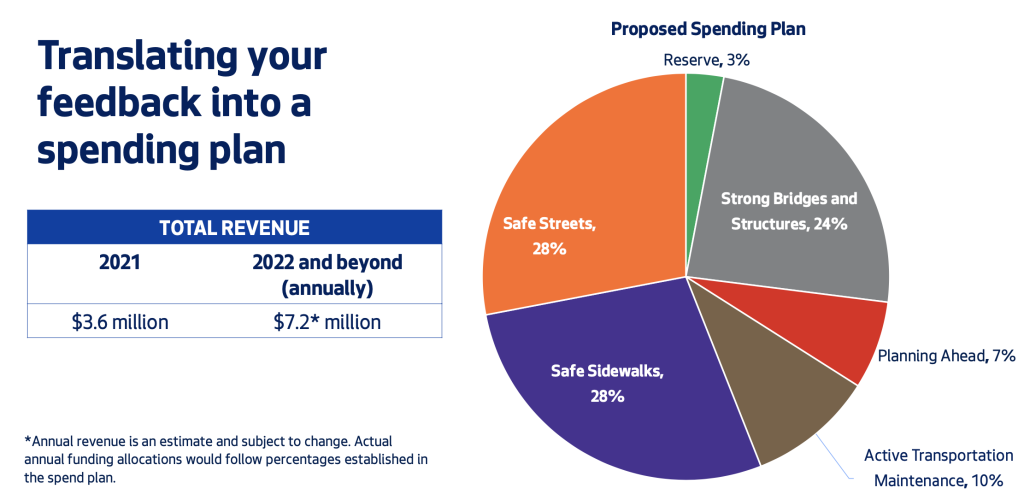
Five months ago, Councilmember Alex Pedersen argued that the $20 vehicle license fee, passed by the city council, should be dedicated to bridge maintenance. Council President M. Lorena González marshalled the votes to delay that spending decision until the spring to allow for outreach and stakeholder engagement work. The Seattle Department of Transportation (SDOT) did that work and Councilmember Pedersen is charging ahead anyway with essentially the same priorities and tact as before.
SDOT transmitted a spending plan with 28% for safe streets, 28% for safe sidewalks, 10% for active transportation maintenance, 24% for bridge maintenance, and 7% for long-range multimodal planning, stressing a balancing of needs based on community input from a variety of groups including labor, transportation advocates, advisory boards, and equity stakeholders. The $20 vehicle licensing fee (VLF) is expected to raise $7.2 million per year, goes into effect in July, and does not have a sunset date.
Transportation Chair Pedersen announced an amendment yesterday that raises $100 million via bonding with bridge maintenance jumping to 75% of investment. Sidewalks and active transportation maintenance would be expected to fight for the remaining 25%. Debt service on the bonding would consume $40 million — roughly 29% of revenue over the next 20 years.
Councilmember Pedersen sent out a press release co-signed by Councilmembers Lisa Herbold, Andrew Lewis, and Teresa Mosqueda making the case for bridge maintenance and complimenting the SDOT plan as he tossed it aside.
“We appreciate the Seattle Department of Transportation convening community partners to offer ways to invest the expected funds from the $20 vehicle license fee authorized by the City Council. They have crafted a thoughtful 2021 spending plan that we should implement immediately,” the four councilmembers said in a joint statement. “At this critical juncture, when we seek to build back better after the Covid-19 crisis, we must also think bigger and bolder with this opportunity. We should supercharge the VLF dollars by financing $100 million in bonds in 2022 and take on the too-long-delayed task of fixing our city’s aging multimodal bridges and modernizing Seattle’s transportation infrastructure while creating good, living wage jobs.”
Bridge needs far outweigh proposed bonds
The press release laid out a myriad of bridge needs, far more than the proposed $75 million in bonding could dream of backing, even after leveraged several times over. The funding needed to repair the West Seattle High Bridge looms large at an estimated $233 million in total capital costs, but Chair Pedersen’s release called out plenty of other big ticket items, too, including “millions to start the seismic retrofits of 16 Seattle bridges, including $32 million for Ballard, $29 million for Fremont, and millions to seismically upgrade the 100-year-old University Bridge”, and untold millions for the 2nd Avenue South Extension Bridge.
If that weren’t enough to worry about, the councilmembers also highlighted a desire to replace the Magnolia Bridge. Councilmember Lewis campaigned on a 1:1 replacement for the Magnolia Bridge, as did his opponents in the District 7 race in 2019. SDOT estimates the 1:1 replacement option would cost $340 million to $420 million in 2018 dollars in its 2019 study, which Ryan Packer argued was flawed since it relied on outdated traffic models and discounted a cheaper Armory Way alternative. Nonetheless, Councilmembers stress “millions to replace the 90-year-old Magnolia Bridge, which is part of the Ballard-Interbay Regional Transportation (BIRT) corridor” as an immediate need. The BIRT study was also very flawed, by the way.
Thus, Pedersen and company have identified more than $1 billion in bridge needs over the next twenty years, but they’re raising just $75 million via this proposal. Even hoping for generous federal backing via President Joe Biden’s jobs plan, Pedersen’s proposal isn’t likely to make much of a dent. However, the proposal would add $40 million in very real debt service costs without actually identifying what big ticket project we get upfront to warrant the bonding approach.
Cutting $80 million in multimodal funding
Without Pedersen’s bonding scheme, the $20 VLF is projected to raise $144 million in revenue over the next 20 years. That equals $40.3 million for safe sidewalks, $40.3 million for safe streets, $14.4 million for active transportation maintenance, and $10 million for long-range multimodal planning under SDOT’s spending plan. Pedersen’s plan meanwhile would throw just $25 million toward those priorities — $80 million less than SDOT’s plan. That’s a huge downgrade that could starve those programs of resources. Even bridge maintenance would collect $34.5 million over the next 20 years under SDOT’s plan, which isn’t that much less than the $75 million in the bonding plan.
Is bonding appropriate for bridge maintenance?
It’s true having that money upfront would be nice, but bonding only makes sense if it gets us a project we couldn’t otherwise fund in a reasonable timeline. Pedersen hasn’t singled out a project — instead offering an impossibly large grab bag — so we have no way to know.
“Our bridge audit showed so many bridges in poor condition and illustrated the economic benefits of front-loading government resources,” Pedersen and his three council allies argued in their joint statement. “By leveraging these dollars, we can finally commit to a strategy of significant timely investments rather than piecemeal fixes.”
On the contrary, frontloading a small revenue source is still a piecemeal approach since most of the bridge maintenance backlog remains unaccounted for and unfunded. Adding $40 million in debt service is a big decision that shouldn’t be launched into so cavalierly. We need to know what we’re bonding for and if more funding is on the way to close out the bridge maintenance backlog.
SDOT’s rigorous outreach process could have vetted the bonding and expanded bridged maintenance idea, but Pedersen opted to wait until the last minute to roll out his proposal. That leaves a very disjointed process with a far superior thoroughly vetted SDOT proposal now in limbo because the council transportation chair prefers to shoot from the hip.
At the transportation committee meeting this Wednesday at 9:30am, councilmembers will discuss VLF spending and Pedersen’s amendment (Council Bill 120042). Councilmember Pedersen said he hopes to vote his proposal out of committee on May 5th. Councilmembers will weigh SDOT’s proposal against Pedersen’s in the meantime.
The Urbanist has urged councilmembers to oppose Pedersen’s amendment. Our letter is below if you’d like to crib any notes as you call or email councilmembers.
Doug Trumm is publisher of The Urbanist. An Urbanist writer since 2015, he dreams of pedestrian streets, bus lanes, and a mass-timber building spree to end our housing crisis. He graduated from the Evans School of Public Policy and Governance at the University of Washington in 2019. He lives in Seattle's Fremont neighborhood and loves to explore the city by foot and by bike.



